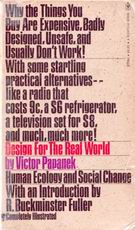
Design for the Real World
Human Ecology and Social Change
Papanek, Victor
Publisher: Bantam, New York, USA
Year First Published: {15524 Design for the Real World DESIGN FOR THE REAL WORLD Human Ecology and Social Change Papanek, Victor Bantam New York USA While two-thirds of the world's population lives in poverty, valuable human and natural resources are used to produce: fur-covered toilet seats, electronic nail polish dryers, diapers for parakeets, and mink-oil fertilizer for "the plant that has everything." Papanek discusses why the things you buy are expensive, badly designed, unsafe, and often don't work. He proposes alternative ways of thinking and alternative designs for safe, inexpensive, and desperately needed products. 1970 1973 378pp $2.25 BC15524s-Papanek-DesignRealWorld.jpg B Book -
<br>
<br>
<br>Table of Contents:
<br>
<br>Introduction, by R. Buckminster Fuller
<br>Preface
<br>
<br>Part One / Like It Is
<br>1. What is Design?
<br> A Definition of Design and the Function complex
<br>2. Phylogenocide
<br> A History of the Industrial Design Profession
<br>3. The Myth of the Noble Slob
<br> Design, "Art," and the Crafts
<br>4. Do-It-Yourself Murder
<br> The Social and Moral Responsibilities of the Designer
<br>5. Our Kleenex Culture
<br> Obsolescence, Permanence, and Value
<br>6. Snake Oil and Thalidomide
<br> Mass Leisure and Phony Fads in the Abundant Society
<br>
<br>Part Two / How It Could Be
<br>7. Rebel With a Cause
<br> Creativity vs. Conformity
<br>8. How to Succeed in Design Without Really Trying
<br> Areas of Attack for Responsible Design
<br>9. the Tree of Knowledge: Bionics
<br> The Use of Biological Prototypes in the Design of Man-made Systems
<br>10. Conspicuous Consumptives: Design and the Environment
<br> Pollution, Crowding, Starvation, and the Designed Environment
<br>11. The Neon Blackboard
<br> The Education of Designers and the Construction of Integrated Design Teams
<br>12. Design for Survival and Survival Through Design
<br> What Can We Do?
<br>
<br>Bibliography CX7385 1 true true false CX7385.htm [0xc000b2c450 0xc000b73830 0xc000dfa180 0xc00180f470 0xc00180fe90 0xc001a34330 0xc001a9dd40 0xc001b32420 0xc001b32480 0xc0007675c0 0xc0002b83f0 0xc0002b8930 0xc0002b8fc0 0xc0002b94a0 0xc0002b9500 0xc0002b9590 0xc0002e7b30 0xc0004704e0 0xc000470660 0xc000535950 0xc00061ff50 0xc00062e480 0xc00062e510 0xc00062e600 0xc00062e690 0xc00062e750 0xc00062e8a0 0xc00062ea20 0xc00062ea80 0xc00062eb40 0xc00062ec90 0xc00062ed50 0xc000167650 0xc000802c90 0xc000802cf0 0xc000802e40 0xc000802ed0 0xc000802f00 0xc00053e7b0 0xc000888540 0xc00019c7e0 0xc0004892f0 0xc000489470 0xc0004a1020 0xc000630de0 0xc000bc4a50 0xc000cb8960 0xc0015228a0 0xc000a23ef0 0xc0019c45a0 0xc000391a10 0xc000f2a960 0xc000f2a9f0 0xc000f2aa50 0xc000f2ab70 0xc000f2ac60 0xc000f2adb0 0xc0018471a0 0xc001b56d50 0xc000c95590 0xc00153faa0 0xc00214ac90 0xc00214b350 0xc0021b6000] Cx}
Year Published: 1973
Pages: 378pp Price: $2.25 Resource Type: Book
Cx Number: CX7385
While two-thirds of the world's population lives in poverty, valuable human and natural resources are used to produce: fur-covered toilet seats, electronic nail polish dryers, diapers for parakeets, and mink-oil fertilizer for "the plant that has everything." Papanek discusses why the things you buy are expensive, badly designed, unsafe, and often don't work. He proposes alternative ways of thinking and alternative designs for safe, inexpensive, and desperately needed products.
Abstract:
-
Table of Contents:
Introduction, by R. Buckminster Fuller
Preface
Part One / Like It Is
1. What is Design?
A Definition of Design and the Function complex
2. Phylogenocide
A History of the Industrial Design Profession
3. The Myth of the Noble Slob
Design, "Art," and the Crafts
4. Do-It-Yourself Murder
The Social and Moral Responsibilities of the Designer
5. Our Kleenex Culture
Obsolescence, Permanence, and Value
6. Snake Oil and Thalidomide
Mass Leisure and Phony Fads in the Abundant Society
Part Two / How It Could Be
7. Rebel With a Cause
Creativity vs. Conformity
8. How to Succeed in Design Without Really Trying
Areas of Attack for Responsible Design
9. the Tree of Knowledge: Bionics
The Use of Biological Prototypes in the Design of Man-made Systems
10. Conspicuous Consumptives: Design and the Environment
Pollution, Crowding, Starvation, and the Designed Environment
11. The Neon Blackboard
The Education of Designers and the Construction of Integrated Design Teams
12. Design for Survival and Survival Through Design
What Can We Do?
Bibliography
Subject Headings


